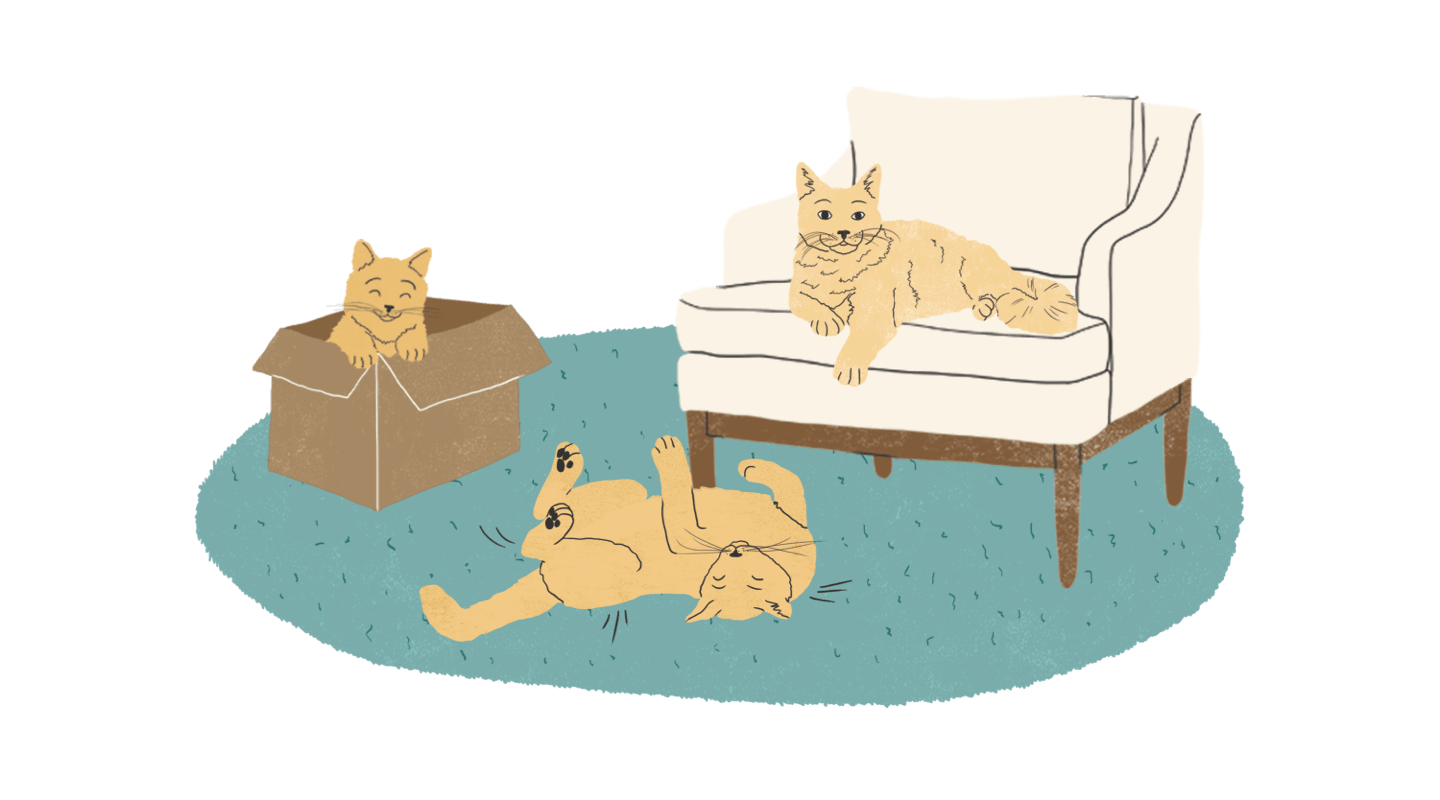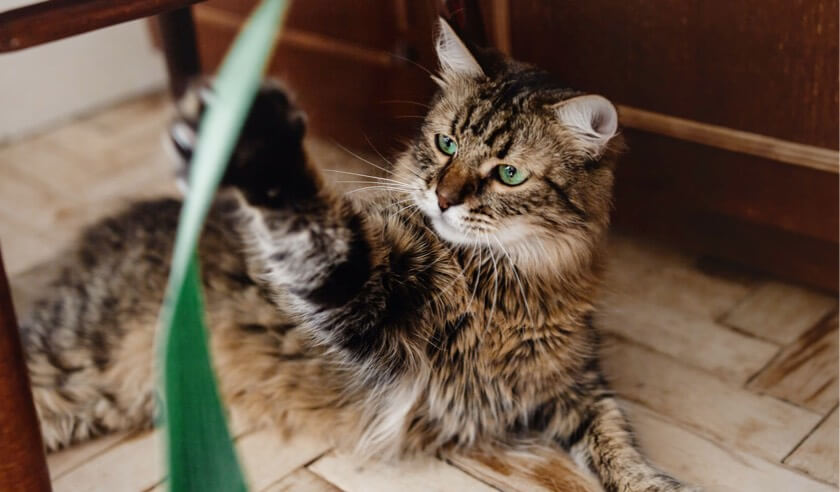Senior cats have this sense of wisdom about them, but they may not be as playful as they once were. However, they’re full of love! One of the best ways we can show our love in return is to be prepared for what they will face as seniors and do what we can to help them through those changes gracefully. We may even be able to help with some of changes we thought were inevitable.
What Age Is a Cat Considered a Senior?
Cats are generally considered senior around 8 to 10 years of age.1 With many cats living into their late teens or early 20s, this means our cats often live half their lives as seniors. When age-related issues start to set in, regardless of your pet’s actual age, they are a senior.
Physical and Behavioral Changes in Senior Cats
Cats are known for many things, but two stand out — agility and cleanliness. As they reach their later years, mobility and grooming can become more difficult, so you’ll start to see changes in their appearance and how they get around.
Appearance:
- They may lose weight or gain weight more readily.
- Their skin will become thinner and more delicate.
- You may see more fur matting, particularly in areas that require flexibility to reach, like the back.
- They may have a harder time keeping their backend clean.
- Nails may grow longer or thicker.
Behavior:
- You may see changes in the social relationships between your senior cat, the family, and other pets.
- There may be changes in their eating and drinking habits.
- Mobility will decrease, meaning they’ll be less active and may have difficulty getting up high or in and out of litter boxes with higher openings.
- Things to watch for is to observe them going up and down stairs and how they jump on and off objects.
Caring for a Senior Cat Around the Home
There are some simple ways to make your cat more comfortable as they age. You can also do a lot to make your home more suitable for your senior kitty:
- Put down runners or mats on slippery floors to provide more traction and prevent slipping.
- Keep your cat’s nails trimmed, so they aren’t slipping and sliding. Overly long nails can also affect their posture and cause back pain.
- Train your cat to use a ramp or steps to get on and off the furniture if they aren’t jumping well.
- Orthopedic or heated beds can be soothing for cats with achy joints and muscles.
- Brush your cat often to minimize matting. A soft bristle brush is easier on delicate skin.
- If your cat isn’t grooming on their own, cat bath wipes can help keep them clean.
- Consider trimming long fur and fur around the backend, making self-grooming easier.
- Try a litter box with a lower opening so they can get in and out easily. If they can’t squat to pee, high sides or pee pads around the box can be helpful.
- Just because they’re less active doesn’t mean they should sleep all day. Keep up with light play if they’re able. And don’t forget about mental enrichment to keep their minds active.
Medical Changes in Senior Cats
As your senior cat changes on the outside, they’re also changing on the inside. Regular veterinary exams are an important part of caring for a senior cat. They’re recommended about every six months to catch new issues early and monitor the progression of existing issues.
The most common health issues for senior cats tend to be:
- Arthritis
- Kidney disease
- Hyperthyroidism
- Dental disease
Helping Your Senior Cat Through Common Medical Issues
Arthritis
Arthritis is a slow and progressive disorder that results in pain and inflammation. Age and obesity significantly contribute to its development. Any joint in the body, the hips, knees, shoulders, elbows, and spine can be impacted by arthritis.
Arthritis can be challenging to diagnose in a cat. They’re masters at hiding pain. Owners often don’t notice that their cats have arthritis until it’s in the advanced stages and there’s already severe damage to the joints. Cats can also handle bone and joint issues better than dogs because of their small size and agility. Therefore, your veterinarian should regularly check for arthritis starting at age seven.
Know how to spot subtle signs of arthritis:
- Changes in activity levels
- Changes in how they jump on and off objects
- Abnormal stride
- Litter box issues
- Reluctance or hesitation with jumping
- Difficulty using stairs
- Changes in behavior
- Decreased grooming activity
Unfortunately, there is no cure, but there are several things you can do to help slow progression, ease discomfort, and improve your cat’s quality of life.
- Maintaining ideal body weight
- Encouraging exercise (while avoiding jumping)
- Joint supplements
- Cold laser therapy
- Acupuncture
- Prescription diets for arthritis
- Veterinary-prescribed pain medications
Kidney Disease
Chronic kidney disease is a progressive and irreversible worsening of kidney function. 80% of cats over 15 will develop kidney failure.2
Recognizing the symptoms of kidney disease is critical. These signs include, but are not limited to:
- Weight loss
- Change in appetite
- Increased thirst
- Increased urination
- Vomiting
- Dehydration
- Lethargy
- Bad breath
- Poor coat
- Diarrhea
The goal of treatment is to slow the progression and manage the symptoms. This includes specialized diets, supplements, proper hydration, and medications to control nausea and stimulate appetite.
Hyperthyroidism
Hyperthyroidism means a cat’s thyroid becomes overactive, and an excess of thyroid hormone is produced. It affects 10% of cats over 10 years of age in the US.3 Since nearly all organs of the body are affected by thyroid hormones, it often causes secondary health problems.
The signs of hyperthyroidism can vary. They may be subtle initially but become more severe. Early detection is key. Look for:
- Weight loss
- Increased appetite
- Increased drinking
- Increased urination
- Restless behavior
- Hyperactivity
- Vomiting
- Diarrhea
- Poor grooming
- Poor coat condition
Several treatment options exist for feline hyperthyroidism. Your veterinarian will help you decide the best course of action based on your cat’s age, other medical issues, treatment cost, and availability of treatment:
Medical Therapy
A medication to help control the production of thyroid hormone
Surgery
To remove the overactive thyroid gland
Radio-Iodine Therapy (also called I-131)
To selectively destroy the overactive thyroid tissue
Prescription Diet Therapy
To control the production of thyroid hormone by restricting iodine intake
Dental Disease
It’s reported that some form of dental disease affects 50% to 90% of cats over four years old.4 It causes significant pain and discomfort and secondary health conditions, all of which greatly impact quality of life.
The most common forms of dental disease are:
Gingivitis
Inflammation of gum tissue with clinical signs including swelling, redness, discomfort, or pain. Bleeding of the gums can occur in severe cases. Cats may have changes in eating behavior, drool, and/or have bad breath. Treatment involves regular removal of plaque by brushing the teeth, and sometimes a professional dental cleaning at your veterinarian’s clinic. Depending on the severity, antibiotics and pain medications may be needed.
Periodontitis
This infection has moved past the gums and attacks the ligaments and bones that support the teeth. Clinical signs include those of gingivitis, as well as exposed tooth roots, loose teeth, or tooth loss. Treatment involves a professional dental cleaning and oral health evaluation by your cat’s veterinary health care team. In some cases, teeth will need to be extracted.
Tooth Resorption
This is the most common cause of tooth loss in cats. The inside structure of the tooth breaks down and then moves to other parts of the tooth. By the time clinical signs are evident, significant damage has already occurred. One of the first things noted is a pinkish defect on the tooth at the gum line. It’s very painful and often affects your cat’s ability to eat. Treatment often requires extraction of the affected teeth, especially in cases where cats are painful. This condition requires regular monitoring and follow-up.
Dental disease can be prevented with regular dental care and early intervention. Here are a few things you can do to help protect your cat and their teeth.
- Daily brushing of teeth with pet toothpaste
- Cat treats that have a Veterinary Oral Health Council (VOHC) seal
- Dental supplements
- Water additives
- Oral rinses
- Dental diets
- Regular professional dental cleanings
Always remember, your veterinarian is your partner in caring for your senior cat. Talk to them about any questions or changes you see as your cat ages.
ZPC-01840R2
- 2021 American Association of Feline Practitioners Senior Care Guidelines. https://journals.sagepub.com/doi/pdf/10.1177/1098612X211021538
- Chronic Kidney Disease. Cornell Feline Health Center. https://www.vet.cornell.edu/departments-centers-and-institutes/cornell-feline-health-center/health-information/feline-health-topics/chronic-kidney-disease. Accessed July 17, 2025.
- 2016 AAFP Guidelines for the Management of Feline Hyperthyroidism. Journal of Feline Medicine and Surgery. https://www.ecats.vet/sites/site-3975/documents/CVC%20Docs/2016%20JFMS-%20AAFP%20Guidelines%20for%20the%20Management%20of%20Feline%20Hyperthyroidism.pdf. Accessed July 17, 2025.
- Feline Dental Disease. Cornell University College of Veterinary Medicine. Feline Dental Disease | Cornell University College of Veterinary Medicine. https://www.vet.cornell.edu/departments-centers-and-institutes/cornell-feline-health-center/health-information/feline-health-topics/feline-dental-disease. Accessed March 19, 2025.





